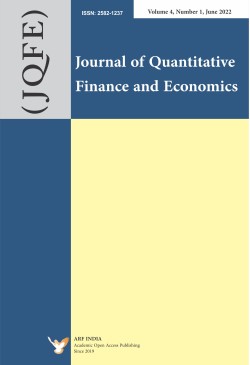
Journal of Quantitative Finance and Economics
Frequency :Bi-Annual
ISSN :2582-1237
Peer Reviewed Journal
The paper studied the impacts of India’s export to the seven African trading blocs during 19952016 especially on GDP growth rate, FDI inflows, inflation rate, Real Effective Exchange Rate, import concentration index and openness of the blocs which directly or indirectly help to speed up the process of trade and financial integration of the African blocs taking data from UNCTAD through BaiPerron model(2003), Fixed effect panel regression model ,the Hausman test (1978, Fisher(1932)Johansen(1991) , Kao(1999) and Pedroni(1999) cointegration models. Vector Error Correction and Wald test(1943)were applied to test causality. The empirical results showed that the growth rate of India’s export to seven African blocs namely, CEMAC, COMESA ,EAC,ECCAS,SACU, SADC and WAEMU have been increasing at the rate of 0.130.19 per cent per annum during 19952017 which have significant upward structural breaks . The fixed effect panel regression assured that one per cent increase in GDP growth rate,FDI inflows, inflation rate, of African blocs led to 0.101 per cent , 0.1185 per cent , 0.1839 increase in India’s export to African bloc blocs but one per cent increase in openness ,REERand import concentration index in African blocs led to 3.586 per cent decrease , 1.15% decrease , 1.388 per cent decrease in Indian export to African blocs during 19952017. Panel cointegration showed that there are at least five cointegrating vectors among them. There are insignificant long run causalities from import concentration index and openness index of 7 African blocs to GDP growth rate and REER .There is short term causality from REER of the African blocs to Indian export to their blocs. And there are short term causalities [i] from import concentration of African blocs to GDP growth rate of African blocs,[ii] from openness of African blocs to inflation rate of African blocs, and [iii] from FDI inflows of African blocs to REER of African blocs respectively. This research may find out to formulate policies on macro variables how to accelerate trade and financial integration of African blocs with India.
Key words: African blocs, India’s exports, panel cointegration, panel vector error correction, short run causality, long run causality,
JEL classification codes: C33, F14, F15, F40, P33
This paper seeks to compare the earnings management behavior of stateowned enterprises in China before and after privatization. The empirical results obtained in the study how that Chinese stateowned enterprises that had been privatized were significantly more aggressive in their earnings management activity after they were privatized. Furthermore, the smaller the stake that the state continued to hold in the company after privatization, the greater the intensity of earnings management is. The character of the largest shareholder in a privatized stateowned enterprise also affects the company’s earnings management behavior.
Keywords: earnings management, privatization, ownership structure, corporate governance, China’s stateown enterprises.
JEL Classification: D210, G340, P310
Applying an extended ISMPAS model (Romer 2000, 2006), this paper finds that the government debtto GDP ratio had a negative impact on real GDP during 19892007 and a positive impact on real GDP during 20082018. In addition, real GDP has a positive relation with the real stock price and a negative relation with real appreciation of the Australian dollar, the U.S. real interest rate, the real oil price and the expected inflation rate. Although fiscal expansion had a positive effect on real GDP, rapid rise in the government debtto GDP ratio in recent years may make the positive relation unsustainable.
Keywords: Fiscal Policy, Monetary Policy Reaction Function, Exchange Rates.
JEL codes: E52, E62, F41
The level of volatility in the stock market is a major determinant factor in taking investment decisions in any of the stock markets. However, the persistent of stock price volatility in the Nigerian stock market has led to low level of participation as a result of associated high level risk in the market. This study examined volatility persistence effects on stock returns in Nigeria stock exchange market after global financial crisis between 2010 and 2018. The study employed weekly secondary data subjected to mean reverting form of GARCH model. Finding revealed that sum of the estimated ARCH and GARCH coefficient (persistence coefficient) for the three distributional assumptions indicates that ASI returns exhibit high volatility ncial crisis at different selection criteria models. The study concludes that ASI returns exhibit high volatility persistence after the global financial crisis. Therefore, it is recommended that the Nigerian stock exchange regulators should make available to the public an efficient information dissemination and software application to enhance ease market information accessibility which in turn improves investor confidence, patronage and liquidity in the Nigerian stock market.
Keywords: Revert in MeanGARCH Model, Global financial crisis, Stock Return, Volatility Persistence and Nigerian Capital Market.
JEL Code: G1, G4